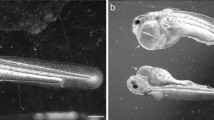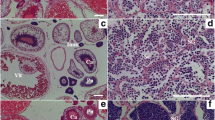Abstract
Loaches (Misgurnus anguillicaudatus) were collected from 35 localities in Japan and assayed by flow cytometry to determine ploidy status. No tetraploids were found, with samples from 33 localities having no or few (1.2–3.2%) triploids. Samples collected from Ichinomiya Town, Aichi Prefecture, showed a relatively high rate of triploidy (7.7%). Samples collected from a fish farm in Hirokami Village, Niigata Prefecture, also showed high proportions of triploids (2.0–15.8%), these triploid males being sterile, but the females producing both large-sized triploid and small-sized haploid eggs. Such eggs developed bisexually rather than gynogenetically, giving rise to viable tetraploid and diploid offspring after normal fertilization. Of eight diploid females obtained from the same locality, one produced a high incidence of viable diploid gynogens (55%) after gynogenetic induction by fertilization with UV-irradiated spermatozoa. These observations indicated the presence of diploid fish which produced both diploid and haploid eggs. Thus, triploid and diploid individuals were also produced after fertilization with haploid spermatozoa. These results suggested that the occurrence of such unreduced eggs may be a cause of natural polyploidization in this species.
Similar content being viewed by others
Literature Cited
Allen, S. K. and J. G. Stanley. 1978. Reproductive sterility in polyploid brook trout,Salvelinus fontinalis. Trans. Am. Fish. Soc., 107: 473–478.
Arai, K., M. Ikeno and R. Suzuki, 1995. Production of diploid androgenetic loachMisgurnus anguillicaudatus using spermatozoa of natural tetraploids. Aquaculture, 137: 131–138.
Arai, K., K. Matsubara and R. Suzuki 1991a. Karyotype and erythrocyte size of spontaneous tetraploidy and triploidy in the loachMisgurnus anguillicaudatus. Nippon Suisan Gakkaishi, 57: 2167–2172.
Arai, K., K. Matsubara and R. Suzuki. 1991b. Chromosomes and developmental potential of progeny of spontaneous tetraploid loachMisgurnus anguillicaudatus. Nippon Suisan Gakkaishi, 57: 2173–2178.
Arai, K., K. Matsubara and R. Suzuki 1993. Production of polyploids and viable gynogens using spontaneously occurring tetraploid loach,Misgurnus anguillicaudatus. Aquaculture, 117: 227–235.
Bogart, J. P. and L. E. Licht 1986. Reproduction and the origin of polyploids in hybrid salamanders of the genusAmbystoma. Can. J. Genet. Cytol., 28: 605–617.
Cherfas, N. B. 1966. Analysis of meiosis in sexual and unisexual forms of the silver carp. Moscow. Vserossiskii Nauchnoissledovatelskii Institut Prudovgo Rybnogo Khoziastva, Trudy, 14: 63–82. (In Russian.)
Cherfas, N. B., B. Gomelsky, N. Ben-Dom and G. Hulata. 1995. Evidence for the heritable nature of spontaneous diploidization in common carp,Cyprinus carpio L. eggs. Aquaculture Research, 26: 289–292.
Cherfas, N. B., B. I. Gomelsky, O. V. Emelyanova and A. V. Recoubratsky. 1994. Induced diploid gynogenesis and polyploidy in crucian carp,Carassius auratus gibelio (Bloch), Xcommon carp,Cyprinus carpio L., hybrids. Aquaculture and Fisheries Management, 25: 943–954.
Cherfas, N. B. and V. A. Ilyasova. 1980. Induced gynogenesis in hybrids between crucian carp and common carp. Genetika (Moscow), 16: 1260–1269. (In Russian.)
Cimino, M. C. 1972. Meiosis in triploid all-female fish (Poeciloipsis, Poeciliidae). Science, 175: 1484–1486.
Cuellar, O. and T. Uyeno. 1972. Triploidy in rainbow trout. Cytogenetics, 11: 508–515.
Dawley, R. M. 1987. Hybridization and polyploidy in a community of three sunfish species (Pisces: Centrarchidae). Copeia, 1987: 326–335.
Dawley, R. M. 1989. An introduction to unisexual vertebrates. Pages 1–18in R. M. Dawley and J. P. Bogart, eds. Evolution and ecology of unisexual vertebrates. Bulletin 466, New York State Museum, Albany, New York.
Dawley, R. M. 1992. Clonal hybrids of the common laboratory fishFundulus heteroclitus. Proc. Natl. Acad. Sci. USA., 89: 2485–2488.
Dawley, R. M., J. H. Graham and R. J. Schultz. 1985. Triploid progeny of pumpkinseed X green sunfish hybrids. J. Hered., 76: 251–257.
Dawley, R. M., R. J. Schultz and K. A. Goddard. 1987. Clonal reproduction and polyploidy in unisexual hybrids ofPhoxinus eos andPhoxinus neogaeus (Pisces; Cyprinidae). Copeia 1987: 275–283.
Flajshans, M., P. Kvasnicka and P. Rab. 1993. Genetic studies in tench (Tinca tinca L.): high incidence of spontaneous triploid. Aquaculture, 110: 243–248.
Hitotsumachi, S., M. Sasaki and Y. Ojima. 1969. A comparative karyotype study in several species of Japanese loaches (Pisces, Cobitidae). Jpn. J. Genet., 44: 157–161.
Li, K., Y. Li and D. Zhou. 1983. A comparative study of the karyotypes in two species of mud loaches. Zool. Res., 4: 75–81. (In Chinese with English summary.)
Matsubara, K., K. Arai and R. Suzuki. 1995. Survival potential and chromosomes of progeny of triploid and pentaploid females in the loach,Misgurnus anguillicaudatus. Aquaculture, 131: 37–48.
Ojima, Y. and A. Takai. 1979. The occurrence of spontaneous polyploid in the Japanese common loachMisgurnus anguillicaudatus. Proc. Japan Acad., 55, Ser. B: 487–491.
Onozato, H., K. Kawamura and Y. Nakayama. 1993. Natural gynogenetic triploid loach in Lake Ohnuma. Abst. Metg. Japan Soc. Fisheries Sci., Sep., 1993: 85, (In Japanese.)
Onozato, H. and S. Nakamae. 1995. Sudden resumption of sexual development in eggs of the natural gynogenetic triploid loach. Abst. Metg. Japan Soc. Fisheries Sci., April, 1995: 181. (In Japanese.)
Raicu, P. and E. Taisescu. 1972.Misgurnus fossilis a tetraploid fish species. J. Hered., 63: 92–94.
Sakaizumi, M., Y. Shimizu, T. Matsuzaki and S. hamaguchi. 1993. Unreduced diploid eggs produced by interspecific hybrids betweenOryzias latipes andO. curvinotus. J. Exp. Zool., 266: 312–318.
Suzuki, R., T. Nakanishi and T. Oshiro. 1985a. Survival, growth and sterility of induced triploids in the cyprinid loachMisgurnus anguillicaudatus. Bull. Japan. Soc. Sci. Fish., 51: 889–894.
Suzuki, R., T. Oshiro and T. Nakamishi. 1985b. Survival, growth and fertility of gynogenetic diploids induced in the cyprinid loach,Misgurnus anguillicaudatus. Aquaculture, 48: 45–55.
Thorgaard, G. H. and G. A. E. Gall. 1979. Adult triploids in a rainbow trout family. Genetics, 93: 961–973.
Uzzell, T., L. Berger and R. Günther. 1975. Diploid and triploid progeny from a diploid female ofRana esculenta: (Amphibia Salientia). Proc. Acad. Nat. Sci. Philad., 127: 81–91.
Zhang, Q. and K. Arai. 1996. Flow cytometry for DNA contents of somatic cells and spermatozoa in the progeny of natural tetraploid loach. Fisheries Sci., 62: 870–877.
Zhang, Q., K. Arai and M. Yamashita. 1998. Cytogenetic mechanisms for triploid and haploid egg formation in the triploid loachMisgurnus anguillicaudatus. J. Exp. Zool., 281: 608–619.
Author information
Authors and Affiliations
Corresponding author
About this article
Cite this article
Zhang, Q., Arai, K. Distribution and reproductive capacity of natural triploid individuals and occurrence of unreduced eggs as a cause of polyploidization in the loach,Misgurnus anguillicaudatus . Ichthyological Research 46, 153–161 (1999). https://doi.org/10.1007/BF02675433
Received:
Revised:
Accepted:
Issue Date:
DOI: https://doi.org/10.1007/BF02675433




